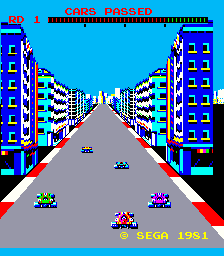Turbo
From Sega Retro
| Turbo | |||||||||||||||||||||
|---|---|---|---|---|---|---|---|---|---|---|---|---|---|---|---|---|---|---|---|---|---|
| System(s): VCO Object, ColecoVision, Intellivision | |||||||||||||||||||||
| Publisher: Sega, Coleco | |||||||||||||||||||||
| Developer: Sega, Coleco | |||||||||||||||||||||
| Genre: Racing | |||||||||||||||||||||
|
Turbo (ターボ) is a 1981 arcade game developed by Sega. It is a racing game where the player drives a formula 1 car down a long road while avoiding other cars and obstacles.
Turbo is often considered the first racing game to introduce a third-person perspective to the genre, something that is largely taken for granted now. A third-person perspective had earlier been achieved by Sega's Fonz in 1976, and a first-person perspective by Atari's Night Driver the same year, but the weak technology of the era meant that Fonz was monochrome and Night Driver could only produce white squares on a black background (hence the word "Night").
Turbo was revolutionary in that it could display colourful, detailed backgrounds, with sprite scaling, which gave the impression that the car was moving forwards. What is also notable is that Turbo offers changes of scenery, so the player can drive through cities, along the coast, through tunnels and through snow. Turbo would go on to inspire Namco's successful Pole Position arcade title, which in turn would help to popularise the genre. Pole Position is arguably a less advanced game, in terms of scale, as the scenery does not change.
The gameplay is similar to Sega's earlier arcade title, Monaco GP. Like Monaco GP, its arcade cabinet displays the player's score and speed on separate LED displays, meaning that when the game is emulated, extra considerations must be taken. In MAME for example, there is an option to display these values on the left hand side of the main screen, but this would not have been present on real hardware.
Contents
History
Development
Programmer Steve Hanawa was hospitalized after spending hours coding and debugging Turbo.
Release
Turbo was ported to the ColecoVision and Intellivision in 1982, though many cuts were made in order for the game to run on the weaker hardware of these consoles. An Atari 2600 port was planned, but cancelled. However in recent years a prototype version of the Atari 2600 game has been unearthed. The ColecoVision version of the game was, for a while, bundled with the ColecoVision Expansion Module #2 - a steering wheel.
A Turbo board game was released by Milton Bradley in 1983.
Production credits
- Designer & Programmer: Steve Hanawa
Magazine articles
- Main article: Turbo/Magazine articles.
Promotional material
Physical scans
VCO Object version
| VCO Object, JP | ||||
|---|---|---|---|---|
ColecoVision version
| Sega Retro Average | |||||||||||||||||||
|---|---|---|---|---|---|---|---|---|---|---|---|---|---|---|---|---|---|---|---|
|
| 93 | |
|---|---|
| Based on 3 reviews | |
| ColecoVision, US (Expansion Module bundle) |
|---|
|
| ColecoVision, EU |
|---|
|
50x50px Cart |
Intellivision version
Atari 2600 version
References
- ↑ File:TVGamer UK 02.pdf, page 18
- ↑ Arcade Express, "Volume One, Number Twelve: January 16, 1983" (US; 1983-01-16), page 7
- ↑ TeleMatch, "August/September 1983" (DE; 1983-07-25), page 28
- ↑ Tilt, "Septembre/Octobre 1983" (FR; 1983-0x-xx), page 46
- No players field
- ColecoVision games
- Intellivision games
- All games
- Use Creditstable template
- Old-style rating (arcadeexpress)
- External rating reference
- Rating without PDF source
- Old-style rating (joystik)
- Old-style rating (telematch)
- Old-style rating (tilt)
- Update ratings template
- 4 old ratings
- Pages with broken file links
- VCO Object games







